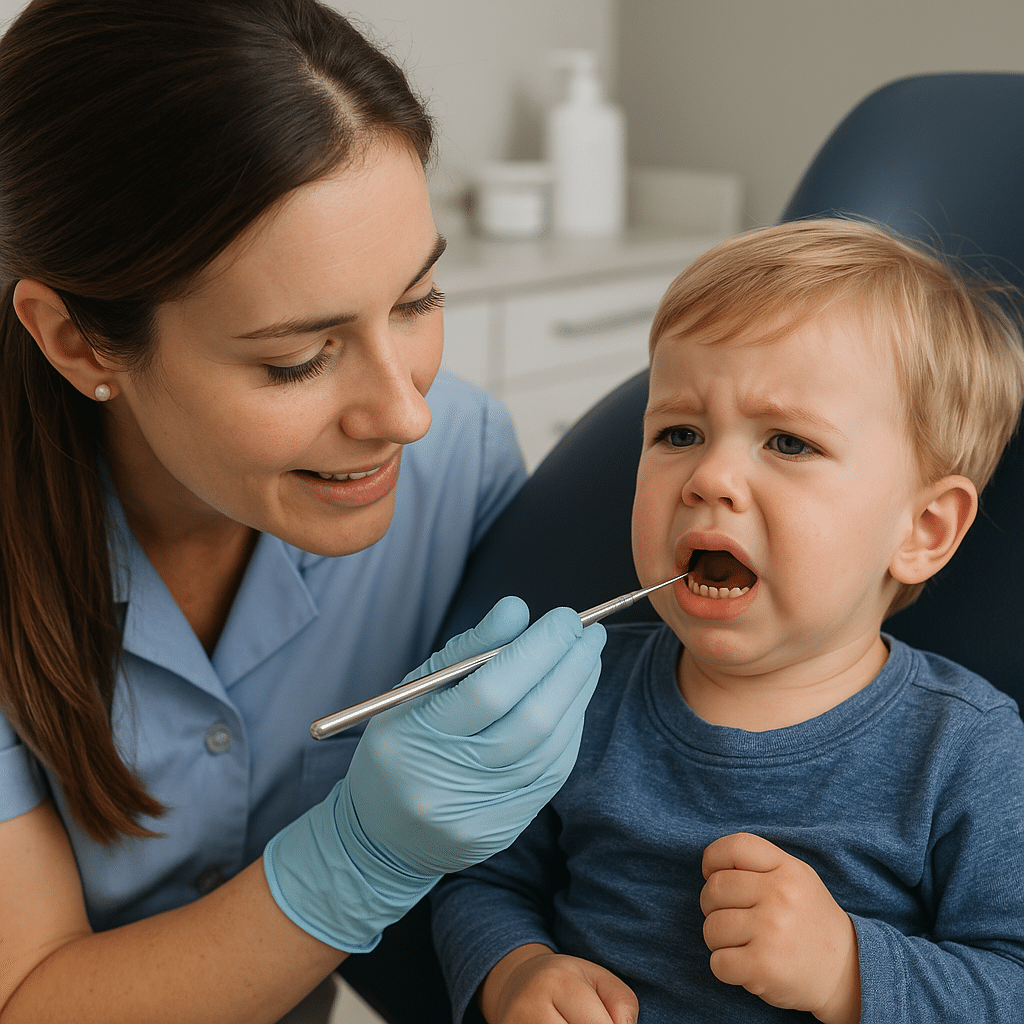Toddlers can’t always tell you when something hurts—and when it comes to dental infections, early detection is critical. What might look like a small cavity or gum irritation can quickly escalate into pain, swelling, and even systemic illness.
As a parent, knowing how to spot the signs of a dental infection and taking fast action can protect your child from unnecessary discomfort and prevent long-term damage.
In this article, we’ll cover the 5 most common signs your toddler may have a dental infection, what causes them, and what steps to take next.
1. Swollen or Red Gums Around One Tooth
One of the first visual signs of infection is localized swelling or redness around a single tooth. This can indicate a developing abscess—a pocket of pus caused by bacterial infection.
Your toddler may resist brushing the area or flinch when you try to touch it. Gums may also appear shiny or bulging.
What to do:
Rinse their mouth gently with warm salt water if possible, and contact your pediatric dentist immediately for an evaluation.
2. Unusual Fussiness or Trouble Sleeping
If your normally cheerful toddler is suddenly cranky, clingy, or having trouble sleeping through the night, it might be more than a rough day. Dental pain—especially from infection—often worsens when lying down due to increased blood flow to the head.
If the fussiness is paired with drooling, decreased appetite, or rubbing the cheek or jaw, it may be a tooth-related issue.
What to do:
Monitor the behavior closely and look for any accompanying symptoms like fever or swelling. A dental visit is recommended even if you’re unsure—it’s better to rule out a problem early.
3. Bad Breath That Doesn’t Go Away
While “toddler breath” is normal after meals or naps, persistent bad breath (halitosis) can indicate an underlying infection. When bacteria accumulate due to decay or abscesses, they release foul-smelling gases.
If your child’s breath smells sour or rotten despite good oral hygiene, it’s time to investigate further.
What to do:
Brush your toddler’s teeth and tongue gently and check for dark spots, swelling, or pus. Contact a pediatric dentist for diagnosis.
4. Fever Without Another Clear Cause
A low-grade fever can be the body’s way of fighting a localized infection, including dental abscesses. If your child has a temperature above 100.4°F (38°C) without symptoms of cold or flu, dental infection should be considered.
Fever accompanied by facial swelling or extreme fatigue is especially urgent.
What to do:
Call your pediatric dentist right away. If your child has a high fever and facial swelling, seek emergency dental or medical care, as infections can spread quickly in young children.
5. Visible Changes to the Tooth or Gums
Look out for:
- Dark or gray discoloration of a tooth (could signal a dead or dying nerve)
- A small pimple or bump on the gum (often called a gum boil or fistula)
- Pus or blood coming from the gumline
These are strong indicators of an abscess or advanced decay and require prompt professional care.
What to do:
Do not attempt to drain or treat it at home. Apply a cold compress for swelling and call your dentist as soon as possible.
What Causes Dental Infections in Toddlers?
The most common causes include:
- Untreated cavities
- Tooth trauma (such as a fall that cracks a tooth)
- Poor oral hygiene
- Prolonged exposure to sugary drinks (bottles at night, juice, etc.)
Because baby teeth are thinner and have softer enamel than adult teeth, decay and infection can spread more quickly.
How to Prevent Dental Infections
- Brush your child’s teeth twice a day with fluoride toothpaste
- Start flossing as soon as teeth touch
- Limit sugary snacks and drinks
- Schedule regular dental check-ups every 6 months
- Address any visible cavities or trauma early
OSO Pediatric Dentistry: Here When You Need Us Most
At OSO Pediatric Dentistry, we take dental emergencies seriously. Our experienced, gentle team is here to help identify infections early, relieve your child’s discomfort, and create a treatment plan that works for your family.
📞 Call us at (805) 204-2910 right away if your toddler shows signs of a dental infection—we’ll take care of that little smile with compassion and expertise.

